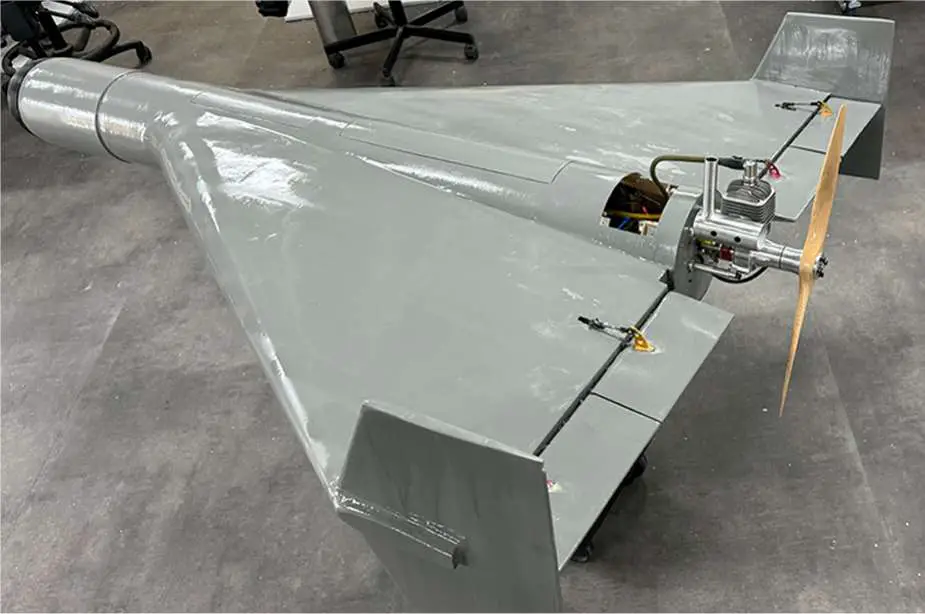Breaking news
Israeli Air Force to train with replica of Iranian Shahed 136 suicide drone.
As reported by Zona Militar on April 10, 2024, Smart Drones, an Israeli company, recently unveiled a detailed replica of the Iranian Shahed 136 unmanned aerial vehicle (UAV), named Delta-wing RS2. This UAV replica, along with others, is being produced primarily for use by the Israeli Air Force and defense companies as part of their training operations, integrated into what is known as a "Red Squadron."
Follow Army Recognition on Google News at this link

This detailed replica of the Iranian Shahed 136 drone, named Delta-wing RS2, is being produced primarily for use by the Israeli Air Force as part of their training operations. (Picture source: RC Team)
A "Red Squadron" or an "Aggressor Squadron" is a concept employed by various air forces, including the Israeli and US air forces, to simulate enemy tactics and capabilities during training exercises. These units aim to enhance the realism of pilot training by mimicking the equipment and tactical approaches of potential adversaries. The Israeli Air Force utilizes the 115 Squadron, also called the "Flying Dragon" or "Red Squadron," for this purpose, similarly to how the United States Air Force uses the 18th Aggressor Squadron at Eielson Air Force Base in Alaska and the 64th Aggressor Squadron at Nellis Air Force Base in Nevada. Aircraft in these squadrons are often painted in camouflage patterns typical of potential enemy forces and are flown by pilots trained in adversary tactics.
As the use of UAVs in warfare has increased, so has the need for realistic UAV targets in training scenarios. The Israeli company Smart Drones, which specializes in Beyond Visual Line of Sight (BVLOS) technologies, has developed several UAVs for this purpose. According to Dudi Ohayon, COO of Smart Drones, these UAVs could also serve as targets to test and enhance air defense systems.
Among their products are the Predator, with a length of 3.2 meters, a maximum speed of 65 meters per second, and a range of 40 kilometers; and the RS-1, a jet-powered UAV that is 2 meters long, reaches speeds of 100 meters per second, and has an 80-kilometer range. The recent addition to their UAV range, the Delta-wing RS2, closely replicates the features of the Iranian Shahed 136, a drone used by Iranian forces and Russia in various conflict zones, including Lebanon and Ukraine.
The Shahed 136, a UAV developed by the Iran Aircraft Manufacturing Industrial Company (HESA), is classified as a loitering munition or suicide drone, designed for direct ground attacks. It features a delta-wing design with stabilizing rudders and is launched from a portable system that can be truck-mounted, facilitating quick deployment. The drone measures 3.5 meters in length and 2.5 meters in wingspan, with a total weight of approximately 200 kilograms. It is equipped with a warhead estimated to weigh between 30 to 50 kilograms and is powered by a four-cylinder, two-stroke piston engine that allows it to reach speeds up to 185 km/h. Its operational range can extend up to 2,500 kilometers, depending on its configuration and operational conditions, and it uses a combination of inertial navigation and satellite systems for navigation.
Additionally, the increasing global reliance on drones has prompted Smart Drones to collaborate with RC Team Aviation, another Israeli tech firm, focusing on the rapid production and deployment of UAV targets to simulate both manned and unmanned aircraft. As noted by Brigadier General (Ret.) Yoni Saida-Marom, CEO of Smart Drones and a former Israeli Air Force official, the transition to UAVs in military strategy marks a shift in aerial warfare tactics, highlighting the importance of adapting training and air defense mechanisms to current and future military threats.























